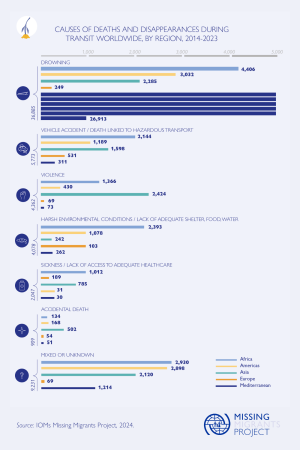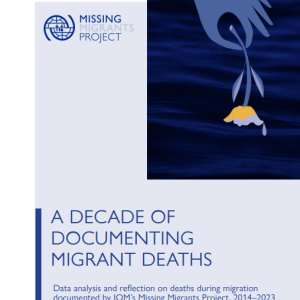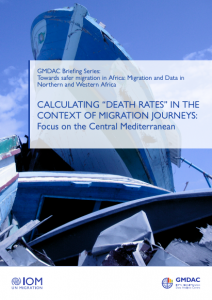Migrant deaths and disappearances
Since 2014, more than 4,000 fatalities have been recorded annually on migratory routes worldwide. 2023 marked the deadliest year with more than 8,000 deaths recorded, marking a decade of documenting migrant deaths. The number of deaths recorded, however, still represent only a minimum estimate because the majority of migrant deaths around the world go unrecorded. These data not only highlight the issue of migrant fatalities and the consequences for families left behind, but can also be used to assess the risks of irregular migration and to design policies and programmes to make migration safer.
Recent trends
IOM’s Missing Migrants Project, the only current effort to document migrant deaths worldwide, has recorded the deaths and disappearances of more than 63,000 women, men and childrensince beginning data collection in 2014:
- Between 2014 and 2023, one of each three people who died during migration died while fleeing a country in conflict.
- Drowning was the main cause of death during migration globally (60%) in the past decade.
Missing Migrants: Causes of death and disappearances during transit worldwide, by region, 2014 - 2023The most updated figures can be consulted in the Missing Migrants Project website at https://missingmigrants.iom.int/data. Visit the Project’s methodology page to see how figures are calculated at https://missingmigrants.iom.int/methodology
Source: The International Organization for Migration (IOM)’s Missing Migrants Project, 2024. Data are compiled from a variety of sources including national and local authorities, surveys and interviews with survivors, IGOs, NGOs and media reports. Notes: (a) All numbers reflect only those incidents which IOM could verify – an unknown number of deaths remain unreported; thus these data are minimum estimates only. Comprehensiveness of data varies by region. (b) Figures include both bodies found and migrants who are missing and presumed dead. (c) Figures correspond to deaths that occurred during the process of migration. They exclude deaths that occur once in a destination country that may be indirectly attributable to a migrant’s legal status or immigration policies. (d) Names and boundaries indicated on map do not imply official endorsement or acceptance by IOM. Download the infographic here.
The vast majority of migrant deaths recorded by the project have been in the Mediterranean Sea, where almost 28,000 people have been recorded dead or missing since 2014. The Central Mediterranean route from Northern Africa towards Italy and, to a lesser degree, Malta accounts for the highest number of reported deaths and disappearances during migration, claiming the lives of more than 23,000 people between January 2014 and March 2024. Several other regions of the world have seen thousands of deaths during migration since 2014. More than 14,500 deaths have been recorded across the African continent, many of which occurred on transit routes on the maritime route from West Africa to the Spanish Canary Islands and across the Sahara Desert crossing, the deadliest land crossing on record (6,204). The deaths of more than 7,250 people have been documented during migration in Asia since 2014, often linked to Rohingya refugees and Afghan nationals who died fleeing outbreaks of violence in their home countries. 2023 marked the deadliest year for Rohingyas and Afghans, marking the highest death toll for Asia since 2014. In the Americas, more than 89200 people have been reported dead or missing during migration since 2014. More than half of these deaths were documented on the border between Mexico and the United States, which is the second deadliest land crossing in the world (5,289). Deaths due to violence globally are on the rise, with 2,322 killings documented between 2021 and 2023 totaling more than the 2,040 recorded in the seven years prior between 2014 and 2020. Although some of the increase in migrant deaths may be a result of improving data sources, it also demonstrates increasing risks for migrants worldwide.
Definition
There is a range in how migrant deaths are defined. The International Organization for Migration (IOM)’s Missing Migrants Project documents deaths and disappearances of people in the process of migration towards an international destination. This definition is similar to that used by other initiatives, such as the Deaths at the Borders Database in Europe, except that it also includes migrants who have gone missing while traversing bodies of water on their journey. This approach is chosen because deaths that occur at physical borders and while en route represent a clearly definable category, and inform the risks that people face on different migration routes around the world. Unidentified remains found at border crossings or on major migratory routes may be categorized as migrants based on their belongings and the characteristics of their deaths. For example, the death of a Honduran national who fell off a freight train in Mexico may be recorded as a migrant death given that Central American migrants frequently use the network of freight trains, commonly known as La Bestia (The Beast) to travel through Mexico to reach the United States (US) border. Because these deaths often occur during irregular migration, data collection and analysis of migrant deaths are highly related to this topic.
Other sources of data may also include deaths which are not included in IOM’s Missing Migrants Project, such as those that:
- Occur in refugee camps, detention facilities, or housing;
- Take place after deportation or forced return to a migrant’s homeland; or
- Are more loosely connected with migrants’ ‘irregular migration status’, such as those resulting from xenophobia, labour exploitation or other structural discrimination.
Most sources of data on migrant deaths do not include deaths resulting from internal migration or those of long-term foreign residents. Destination and origin state authorities often collect such data.
Back to topData sources
Several primary sources provide information on migrant deaths. Various platforms consolidate these data together at the global, regional, national, and local levels.
Data collection at the global level:
IOM’s Missing Migrants Project, which started in 2014, is the only database that collects data on migrant deaths worldwide. The sources of data used vary depending on the availability within each region. For example, in the Mediterranean region, local staff from IOM relay data from when they assist survivors at disembarkation points in Libya. On the US-Mexico border, data are compiled based on data from US county medical examiners and sheriffs’ offices, Mexican Search and Rescue (SAR) bodies and media sources. On the Sahara Desert crossing survey data from IOM’s Displacement Tracking Matrix (DTM) are included. Estimates in other regions are based on a combination of official sources, IOM and other UN agencies data, civil society organizations data, and primarily on media reports.
Data collection at the regional level:
Surveys and interviews with migrants can also serve as a source of information about migrant deaths. However, such methods involve the inability to verify reported information, the possibility of double counting the same incident reported independently by more than one respondent, and relatively small sample sizes that are not necessarily representative. Different sources gather information on migrant fatalities through surveys and interviews at different stages of migration. IOM's Missing Migrants Project receives data on migrant deaths collected through the Flow Monitoring Surveys conducted by IOM's Displacement Tracking Matrix (DTM) in Mali, Niger, Libya and Chad.
Datasets: In terms of consolidating primary information, there are several datasets at the regional level:
- UNHCR collects information about migrant deaths occurring in the Mediterranean Sea, though they produce only a single summary figure without publishing their methodology and underlying data.
- Deaths at the Border Database collected data from local authorities in Greece, Gibraltar, Italy, Malta and Spain on the bodies of migrants who died between 1990 and 2013.
- Australian Border Deaths Dataset, produced by the Border Crossing Observatory in Monash University, Australia, has recorded deaths “associated with Australia’s borders” since 2000.
- Between 2000 and 2016, the Migrant Files, a consortium of journalists, collected information on people who died trying to reach, as well as trying to stay in Europe irregularly. Their records comprise news articles as well as data from two other databases on migrant deaths: the data produced by the Dutch organization UNITED for Intercultural Action; and the data from Fortress Europe, which had collected information since the early 1990s. All three of these sources collected their data primarily from media reports, and used a definition of migrant deaths which includes deaths in detention and those connected to irregular legal status.
- Since 2019, the non-governmental organization Caminando Fronteras, has been compiling and publishing data on incidents involving migrant deaths and disappearances on the West Africa Atlantic Route (WAAR) to the Canary Islands.
Data collection at the local and/or national Level:
- Case studies: The International Labour Organization (ILO) has published reports and conducts investigations into cases of worker deaths, including those of migrant workers. (For example, ILO, 2021). However, it does not host publicly consolidated records.
- On nationals abroad: Some governments publish records of the deaths of their nationals abroad, whether they died while migrating, in detention or at work. These include:
- Administrative data records: Data on migrant deaths are often not disaggregated from general data on deaths at a federal or local level. Where available, records kept by law enforcement, medical examiners, and death registries may provide data on migrant deaths, though the quality and availability of such records vary greatly. These include:
- US Customs and Border Protection, which publishes the number of “illegal border crossers” who have died crossing the southern border of the country; however, this number only includes cases in which their officers were directly involved.
- Humane Borders, which uses data from the Pima County, Arizona county medical examiner to map the deaths of people who have died while crossing the border.
- Media reports: Social and traditional media often report on events that involve death(s) during migration, though the quality, completeness and accuracy of such reports may vary greatly. The Asociación Pro Derechos Humanos de Andalucía publishes an annual report with estimates of the number of people who died trying to reach Spain irregularly (including across Spain’s sea and land borders), which is based largely off of media reports.
Data strengths & limitations
Data on migrant deaths can be used to inform the discussion on the risks of migration and the effects of immigration and border policies. Migrant deaths data also contributes to the discussion of UN Sustainable Development Goal 10.7, which calls for safe migration, specifically, it informs indicator 10.7.3 on the “[n]umber of people who died or disappeared in the process of migration towards an international destination.” As well as Objective 8 of the Global Compact for Migration, which calls on States to "save lives and establish coordinated international efforts on missing migrant". Nevertheless, data on migrant deaths represent a minimum estimate in all regions, given the numerous challenges related to collecting and consolidating migrant deaths data.
Primary data collection challenges include:
- Few official sources collect and publish data on migrant deaths.
- As deaths occur primarily when migrants travel by irregular means, it means they are often in remote areas chosen with the aim of evading detection. As a result, bodies are often not found or they are not found for a long time, and deaths may not be reported to authorities.
- When deaths occur at sea, many bodies may not be recovered. Without passenger lists, the precise number of missing persons is unknown.
- The involvement of criminal or government actors in the facilitation of irregular migration may make survivors fearful of reporting deaths and some deaths may even be actively covered up.
Challenges related to consolidating data include:
- There is varying quality and comprehensiveness of data across regions. Therefore, attempts to estimate deaths globally may exaggerate the share of deaths that occur in some regions, while under-representing the share occurring in others.
For example, some experts believe that the Sahara Desert crossing is more deadly than that over the Mediterranean Sea. See J, Black (2020), “No one talks about what it’s really like” – risks faced by migrants in the Sahara Desert. Available at https://missingmigrants.iom.int/sites/g/files/tmzbdl601/files/publication/file/ch12-no-one-talks-about-what-its-really-like.pdf
- Different data collectors may use differing definitions of “migrant deaths”, making comparisons difficult.
- Information from media sources may have incomplete or inaccurate coverage.
Another challenge with data on migrant deaths (and with other data on migrants), is to convey the people behind the numbers. As often as possible, the context of deaths should be included in communications about the data, with the aim of humanizing each death and avoiding their normalization. Each number represents a person, as well as the family and community that they leave behind.









